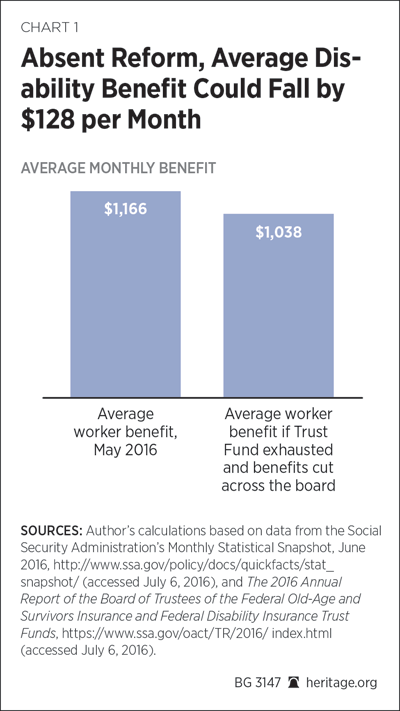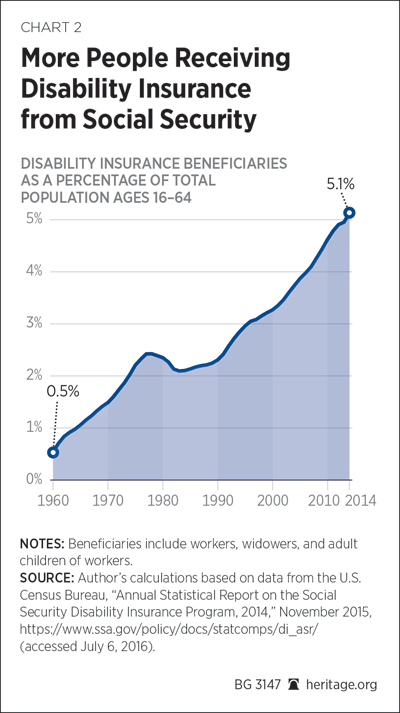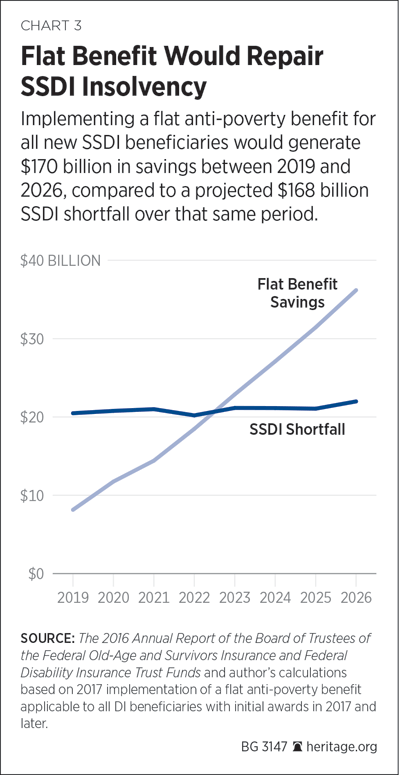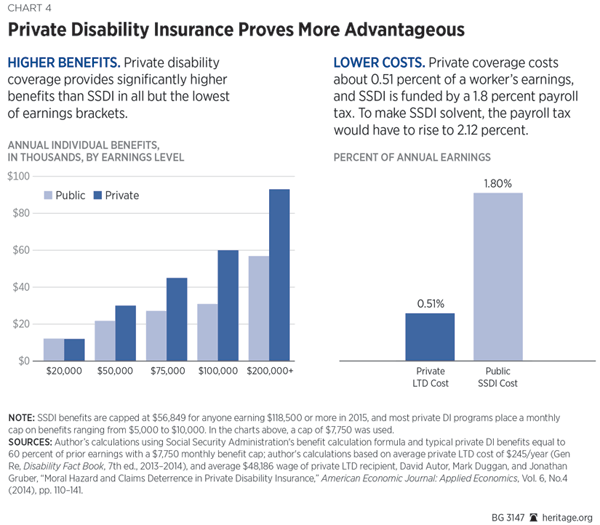Status of the SSDI Trust Fund
According to its Trustees, the Social Security Disability Insurance (SSDI) Trust Fund is on course to run dry in 2023. That is seven years later than the Trustees reported last year, when the SSDI Trust Fund was slated for insolvency in 2016. What happened?
In October 2015, Congress passed a temporary patch to shore up the SSDI program, allowing it to take about $150 billion in revenues over the next three years from Social Security’s Old-Age and Survivors Insurance (OASI) Trust Fund. Despite that significant transfer in revenues, the Social Security Trustees reported that the SSDI program still fails the test of short-term financial adequacy, as its reserves will remain below its annual costs over the next 10 years—even under the Trustees’ low-cost assumptions.
The SSDI program registered its seventh straight deficit in 2015 as the Trust Fund declined by $28 billion, from $60.2 billion in 2014 to $32.3 billion. Each dollar in benefits was met with only 80 cents in payroll tax contributions.[1] These deficits have been possible because the program has been cashing in on interest payments that are due to the Trust Fund as a result of previous borrowing. Since those interest payments come out of general revenues, they add to the federal deficit.
Looming Insolvency. On its current path (which includes many assumptions about the program and economy over the future), the Trustees report that the SSDI Trust Fund will run dry in 2023, at which point incoming revenues will be sufficient to cover only 89 percent of expected benefits.[2]
Absent reform, disability benefits will be cut across the board by 11 percent when the SSDI Trust Fund runs dry. This would reduce the average disabled worker’s benefit by $128 a month, from $1,166 to $1,038. With almost one of every three SSDI recipients already considered to be living below the federal poverty level, and SSDI benefits making up more than 75 percent of beneficiaries’ incomes, an 11 percent cut in benefits could cause significant financial hardship.[3]
While the projected 11 percent reduction in benefits in 2023 is lower than last year’s projected 19 percent cut in benefits if the Trust Fund ran dry in 2016, the difference is primarily the result of demographics as opposed to programmatic changes. By 2023, many of the current baby boomers who are receiving SSDI benefits will have shifted to receiving OASI retirement benefits, leaving a smaller gap in SSDI’s shortfall than would have existed if the program had become insolvent in 2016.
Excessive Growth in SSDI. Over the past 60 years since its inception, the SSDI program has grown far beyond its original goal of protecting disabled workers and their families from poverty. In 1960, just 0.5 percent of the working-age population (ages 16 to 64) received SSDI benefits. Yet, despite significant improvements in health and life expectancy,[4] as well as less physically demanding jobs, the percentage of the working-age population who receive SSDI benefits has skyrocketed, rising to 2.3 percent in 1990 and 5.1 percent in 2014.[5]
A study by the Federal Reserve Bank of San Francisco found that roughly half of the increase in SSDI beneficiaries is the result of demographics, such as increased labor force participation of women and the aging baby-boomer population.[6] However, half the growth—roughly 3 million SSDI beneficiaries with about $42 billion in benefits—is likely the result of greater accessibility to benefits and a higher relative value of benefits.[7]
The SSDI program has increasingly become an early-retirement and long-term-unemployment program serving not only the disabled who truly cannot work, but also the marginally disabled who could hold down certain jobs or work part time. Furthermore, the program is impaired by outright fraud and abuse. Such misuses and abuses undermine the integrity and financial stability of disability insurance.
It is the SSDI program’s unintended growth, and not a lack of tax revenues, that has caused the program’s shortfalls. When the SSDI program first began, the SSDI payroll tax rate was just 0.5 percent. This rate was estimated to be sufficient to provide SSDI benefits to the working population. Despite a significant improvement in health and a shift to more sedentary jobs, the cost of the SSDI program has more than quadrupled. Today, the SSDI tax rate is 2.37 percent including the transfer it is receiving from the OASI program. Although it will revert back to 1.8 percent in 2019, fully funding the program is estimated to cost 2.17 percent of payroll in 2017, and to rise to 2.25 percent of payroll—four and a half times its original cost—by 2085.[8]
Past Time for SSDI Reform
While the current reallocation from the OASI Trust Fund to the SSDI Trust Fund prevented an across-the-board cut in SSDI benefits beginning in 2016, it did almost nothing to improve the SSDI program’s drastic inefficiencies, abuses, or long-run insolvency. Congress should not allow this temporary relief for the SSDI program to delay much-needed reforms as it has in the past.
Last year was not the first time the SSDI program faced insolvency and received a bailout from the OASI program. In 1994, facing growing SSDI costs, the SSDI program received a 50 percent increase in tax revenues through a permanent payroll tax reallocation. At that time, the Trustees warned that the reallocation would not be enough to make the program financially solvent over the long run, and advised Congress to reform the program. Instead of reforming the program, Congress simply sat by and watched it continue to grow until passing another payroll tax reallocation in 2015.
If Congress does not act soon to reform the SSDI program, it will once again become depleted and likely receive another transfer from the OASI Trust Fund. Despite having more IOUs in its trust fund, OASI is more insolvent than SSDI as it faces a roughly 20 percent deficit over the next 75 years compared to SSDI’s 14 percent deficit.[9]
What Should SSDI Reform Include?
Improving the efficiency and integrity of the SSDI program should not be difficult. There are, after all, so many problems that grabbing just the low-hanging fruit could more than solve SSDI’s shortfalls and improve the program for those who truly need it.
A Flat Benefit. For starters, the SSDI program could better serve its original purpose of poverty protection by providing a flat anti-poverty benefit. This would lift many disabled beneficiaries out of poverty, ensure the same level of protection for all workers, and appropriately leave the role of income replacement to the private market.
Even without addressing the SSDI program’s multitude of other problems, a flat anti-poverty benefit alone would more than solve the program’s long-run shortfalls.[10]
Elimination of the Medical-Vocational Grid Rules. SSDI is intended for people who are physically or mentally unable to work. Age, education, level of experience, and ability to speak English do not determine an individual’s ability to work (especially not with the SSDI program’s low standard of any job in the national economy). Yet, the Grid rules[11] allow individuals to receive SSDI benefits simply because of a combination of being age 50 or older, and having limited skills or education, or an alleged inability to speak English.
These non-medical rules come into play in more than half of all SSDI awards, and when an individual meets the Grid standards, an administrative law judge has no choice but to award SSDI benefits. Congress should eliminate the Grid rules and limit SSDI qualifications to strictly mental or physical disabilities.
Optional Private Disability Insurance. Not only does the SSDI provide benefits to too many people, it also fails to provide effective disability insurance to those who truly need it. After having to wait five months between becoming disabled and applying for benefits, SSDI beneficiaries often wait a year or more before they receive a disability determination. This leaves the truly disabled without necessary income support and can cause those seeking disability benefits to deteriorate in health, attitude, and employability.
The private disability insurance market offers a far superior disability insurance product, aimed at helping workers stay on the job or rehabilitating them into a new job. Moreover, it provides higher benefits at a lower cost than the SSDI program. Providing an optional payroll tax credit for employers who offer qualified private disability insurance could significantly improve the well-being of disabled workers (and non-disabled workers who may be considered disabled by SSDI’s flawed determination process), as well as the efficiency of the SSDI system.[12]
Needs-Based Period of Disability. Some disabilities are permanent, some temporary, and some unknown, yet the SSDI program largely treats all disabilities as permanent. While the SSDI system is supposed to assess changes in disabling conditions through continuing disability reviews (CDRs), these reviews often constitute nothing more than a check-the-box postcard, asking the beneficiary to confirm that he is still disabled. The SSDI system should adopt a needs-based period of disability that better reflects the individual’s condition and acknowledges future work capacity.[13] This would mean establishing an expected period of recovery—or lack thereof—alongside beneficiaries’ initial disability determination.
The SSDI program is broken, both financially and in practice. Allowing SSDI to continue unchecked harms taxpayers who finance the program, and beneficiaries who are often stigmatized as a result of widespread fraud and abuse within the program. Congress must not delay SSDI reform once again, and should act now to address the program’s multitude of problems.
—Rachel Greszler is Senior Policy Analyst in Economics and Entitlements in the Center for Data Analysis, of the Institute for Economic Freedom and Opportunity, at The Heritage Foundation.






